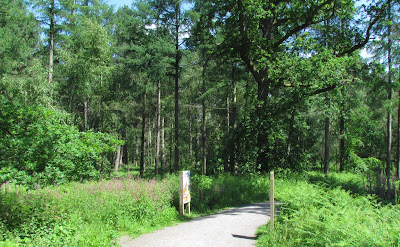Five of us made our way to Lake Vyrnwy on a cloudy day. We met with our hosts for the day and discussed what sort of habitat we would like to visit.
Moorland was agreed. We returned to one of our cars and the RSPB land rover and made our way along the western shore of the lake then taking the Dinas Mawddwy road. We were joined for the first part of the trip by a Rhagionid fly, probably Rhagio scolopaceus, which clung to the window of the car.
The road to the moorland took us alongside the Eunant Fawr and passengers in the car had a splendid view of the stream as it tumbled down the valley and over the waterfall. The drivers on the other hand needed to keep their eyes firmly fixed on the road ahead.
We climbed steadily until we reached the slopes of Waun Drawsfan where we parked.
It was at this point that our hosts declared that the Land Rover had "pinged" indicating low fuel. Fortunately it was downhill all the way back so no panic ensued.
This excellent aerial photograph show the area we were in.
 |
| Photpgraph; Bob Kemp |
A Bilberry bumble bee, Bombus monticola, was spotted on several occasions
 |
| Photograph: David Williams |
An Autumnal rustic
 |
| Photograph: David Williams |
 |
| Photograph: David Williams |
 |
| Photograph: David Williams |
 |
| Photograph: David Williams |
Sorry not the best photograph but as good as I could manage.
Eventually we reached an area where the ground descended slightly into a very wet area. Here the ground was bouncy and it was easy to step from comparatively dry land into a boot overlapping puddle.
The clouds had cleared and the sun was beating down. Just the time and place for lunch.
We felt isolated from the world.
 |
| Photograph: David Williams |
 |
| Photograph: David Williams |
 |
| Photograph: Bob Kemp |
It was time to move on. We followed the Land Rover as it descended down the lake shore then a little way further until we came to a parking and picnic area shown as Llechwedd-dû on an OS map. There was a splendid view across the lake.
 |
| Photograph: David Williams |
But it was not the view that we had come to see, it was the meadow on the other side of the road.
This area was cloaked in lush vegetation; a complete contrast to the moorland. Invertebrate life was far more abundant.
Two species of Sericomyia hoverflies were recorded
Sericomyia silentis
 |
| Photograph: David Williams |
And S. lappona.
 |
| Photograph: David Williams |
The area was so well vegetated that lichens and plants took advantage of any outcrop.
 |
| Parmelia sulcata and Usnia - Photograph: Bob Kemp |
 |
| Photograph: Bob Kemp |
It was getting late; time to move on but not before reproducing a tourist leaflet photograph of the dam wall.
 |
| Photograph: David Williams |
My thanks to the RSPB at Lake Vyrnwy for giving us the opportunity to survey on their site and to Sue Loughran for making the arrangements and providing excellent cake and tea when all the refreshment options of the site had closed. As always my thanks to David Williams and Bob Kemp for their excellent photographs.
The following day found us at a more local site - Haughmond Hill. After gathering in the car park we set off on the gentle but lengthy ascent to the viewpoint pausing every now and then to check out the vegetation bordering the path for invertebrate life.
An early find was a pair of mating Woundwort shieldbugs.
 |
| Photograph: David Williams |
An insect we do not see very often is a snakefly.
 |
| Photograh: David Williams |
A sawfly larva was photographed
 |
| Photograph: David Williams |
A sweep of some dry sparse grassland captured a Bishop's Mitre.
 |
| Photographer: David Williams |
Lunch over we made our way to the north west of the viewpoint to see if the "Scottish hoverfly" was still in residence.
In 2011 I photographed on Little Hill a foothill of The Wrekin what I thought was a bee. It turned out to be a hoverfly. And not just any old hoverfly but one that is was known only in the Caledonian pine forests of Scotland. The hoverfly was Callicera rufa.
It was then found on Haughmond Hill and Nesscliffe. Each of these sites has been checked each year since to ensure that the colonies are surviving and, I am happy to report, they seem to be.
This is the tree on Haughmond Hill on which you may find them.
On this occasion we found a couple, possibly three. Whilst we watched two seemed to spend their time fighting each other, resting a short while on the trunk then resuming their scrap.
I managed an indistinct long distance photograph which is good enough to confirm that one of them was Callicera rufa.
We mooched around the area for a while finding a Wall butterfly, a sand wasp identified as Ammophila sabulosa.
 |
| Photograph: David Williams |
 |
| Photograph: David Williams |
My thanks to The Forestry Commission for giving us permission to do what we enjoy doing and to David Williams for allowing me to use his excellent photographs.






































No comments:
Post a Comment
Please feel free to comment on this post...